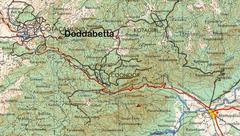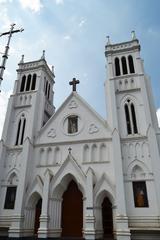Ooty Lake Visiting Hours, Tickets, and Comprehensive Travel Guide
Date: 03/07/2025
Introduction
Ooty Lake, nestled amidst the lush Nilgiri Hills in Tamil Nadu, stands as an emblem of colonial legacy, natural beauty, and vibrant local culture. Established in 1824 by John Sullivan, the then Collector of Coimbatore, the lake was initially constructed for irrigation and fishing (TravelSetu). Today, it is a premier tourist destination, offering serene boating experiences, nature walks, and a host of recreational activities. Managed by the Tamil Nadu Tourism Development Corporation (TTDC), Ooty Lake is also a vital wetland ecosystem supporting diverse flora and fauna (Academia.edu). This guide provides all essential information for visitors, including historical context, ticketing details, activities, ecological significance, and practical travel tips.
Table of Contents
- Early History of Ooty Lake
- Evolution as a Social and Recreational Hub
- Modern-Day Developments and Facilities
- Visiting Hours and Ticket Information
- Accessibility and Travel Tips
- Key Activities and Attractions
- Cultural and Ecological Significance
- Environmental Challenges and Conservation
- Frequently Asked Questions (FAQ)
- Visual Media and Further Resources
- Summary and Final Tips
- References
Early History of Ooty Lake
Ooty Lake was created in 1824 under the guidance of John Sullivan. By damming mountain streams flowing through Ooty valley, the British administration engineered a reservoir that would become central to the nascent hill station (Ooty Wikipedia; Kamaraa). The lake’s establishment reflected the colonial penchant for transforming landscapes for both practical and leisure purposes, and soon became a social focal point for British officials seeking respite from the Indian plains (Mango Hill Hotels).
Evolution as a Social and Recreational Hub
As Ooty developed into the summer capital of the Madras Presidency, Ooty Lake evolved from a utilitarian reservoir to a center of recreation and community. Boating activities were introduced, and the lake became a favored spot for social gatherings and colonial leisure. The completion of the Nilgiri Mountain Railway in 1908 further increased accessibility and popularity, helping transform Ooty Lake into a must-visit attraction (OotyMade; Thrillophilia).
Modern-Day Developments and Facilities
After India’s independence, Ooty Lake was further developed to cater to growing domestic tourism. The TTDC took over management in 1973, introducing enhanced amenities such as a boathouse, pedal, row, and motorboats, a mini amusement park, cycling paths, gardens, food courts, and souvenir shops (HoneymoonBug; thehosteller.com). These facilities make Ooty Lake accessible and enjoyable for visitors of all ages.
Visiting Hours and Ticket Information
- Opening Hours: Daily, 9:00 AM to 6:00 PM (thehosteller.com)
- Entry Fee:
- Adults: INR 30
- Children: INR 10–15
- Boating Charges:
- Paddle boats: INR 150–180 per 30 minutes
- Rowboats: INR 200 per 30 minutes
- Motorboats: INR 300 per 30 minutes
- Additional Fees: Amusement park and mini-train rides have nominal charges.
- Booking: Tickets are available on-site; advance booking is suggested during the peak season and festivals.
Accessibility and Travel Tips
Location
Ooty Lake is located approximately 2 km from Ooty city center, with the Ooty Bus Stop and Ooty Railway Station nearby. Taxis and auto-rickshaws are easily available. The nearest airport is Coimbatore International Airport, 113 km away.
Accessibility
The lake premises are wheelchair accessible, with paved pathways and ramps. Main attractions are suitable for strollers and those with mobility challenges, though some peripheral trails may be uneven.
Travel Tips
- Visit early in the morning to avoid crowds and enjoy cooler weather, especially during weekends or the Ooty Summer Festival in May.
- Carry a light jacket or sweater as temperatures can change rapidly.
- Practice eco-friendly tourism by minimizing plastic usage and disposing of waste responsibly.
- Boating requires life jackets, which are provided by the operators.
Key Activities and Attractions
Boating
The boathouse offers paddle, row, and motorboats for hire. Boating hours align with the lake’s opening hours, and the scenic experience is suitable for families, couples, and solo travelers (thehosteller.com).
Cycling and Horse Riding
A cycling path encircles the lake, with bicycle rentals available. Horse riding along the lakeside is a family-friendly activity, guided by trained handlers (ootytourism.co.in).
Amusement Park and Mini-Train
The mini-train and amusement park rides are especially popular with children, making Ooty Lake a great option for families (tripoto.com).
Nature Walks and Birdwatching
Ooty Lake is surrounded by eucalyptus groves and shola forests, supporting a rich array of resident and migratory bird species (Academia.edu). Guided nature walks and birdwatching tours are available for eco-tourists.
Shopping and Local Cuisine
Souvenir shops and food stalls around the lake offer local handicrafts, woolens, and authentic Nilgiri snacks (tripoto.com).
Nearby Attractions
- Botanical Gardens: 15 minutes’ walk, known for exotic flora.
- Rose Garden & Thread Garden: Ideal for flower enthusiasts.
- Nilgiri Mountain Railway: A UNESCO World Heritage train ride.
- Doddabetta Peak: Highest point in the Nilgiris with panoramic views.
Cultural and Ecological Significance
Cultural Role
Ooty Lake is the epicenter of the annual Ooty Summer Festival in May, featuring boat races, flower shows, and cultural performances (India Beyond Curry). The region’s unique blend of tribal, colonial, and South Indian influences is reflected in its architecture, festivals, and local cuisine (OotyMade).
Ecological Importance
Spanning over 65 acres, Ooty Lake is a critical wetland ecosystem, supporting diverse avifauna and small mammals, including endangered species (Ooty.ind.in). The lake and its surroundings are a hotspot for birdwatchers and nature lovers.
Environmental Challenges and Conservation
Despite its popularity, Ooty Lake faces issues such as silting, water pollution, and habitat disturbance from unregulated tourism (J. Wetlands Biodiversity, 2024). Ongoing conservation initiatives include:
- Pollution control and improved waste management.
- Modernized desilting practices to protect nesting sites.
- Regulating visitor numbers and educating tourists about sustainable practices.
- Community involvement and habitat restoration.
- Pursuit of RAMSAR site designation for enhanced protection.
Frequently Asked Questions (FAQ)
Q: What are Ooty Lake’s visiting hours?
A: 9:00 AM to 6:00 PM daily.
Q: What are the entry and boating charges?
A: Entry: INR 30 (adults), INR 10–15 (children). Boating: INR 150–300 per 30 minutes depending on boat type.
Q: Is Ooty Lake wheelchair accessible?
A: Yes, primary paths are accessible, but some forest trails may be uneven.
Q: Are pets allowed?
A: Generally not, to protect wildlife and ensure cleanliness.
Q: What is the best time to visit?
A: October to June; May is especially lively during the Ooty Summer Festival.
Q: Are guided tours available?
A: Yes, for both nature walks and historical insights.
Visual Media and Further Resources
- High-resolution images of boating, festival events, and birdlife are available on official tourism sites.
- Interactive maps and virtual tours are recommended for pre-visit planning.
- Use alt tags such as “Ooty Lake boating experience,” “Ooty Summer Festival,” and “Birdwatching at Ooty Lake” for image optimization.
Summary and Final Tips
Ooty Lake offers a harmonious blend of history, culture, nature, and recreation. Whether you are boating, enjoying a festival, or exploring the biodiversity of the Nilgiris, the lake provides a multifaceted experience. To protect this unique site for future generations, visitors are encouraged to practice sustainable tourism and respect local customs and wildlife (J. Wetlands Biodiversity, 2024; TravelSetu). For updated travel information, download the Audiala app and follow official channels for the latest news and conservation efforts.
References
- Ooty Wikipedia
- Kamaraa
- TravelSetu
- Thrillophilia
- OotyMade
- HoneymoonBug
- Mango Hill Hotels
- India Beyond Curry
- Trip Planners India
- Academia.edu
- J. Wetlands Biodiversity, 2024
- thehosteller.com
- ootytourism.co.in
- tripoto.com

